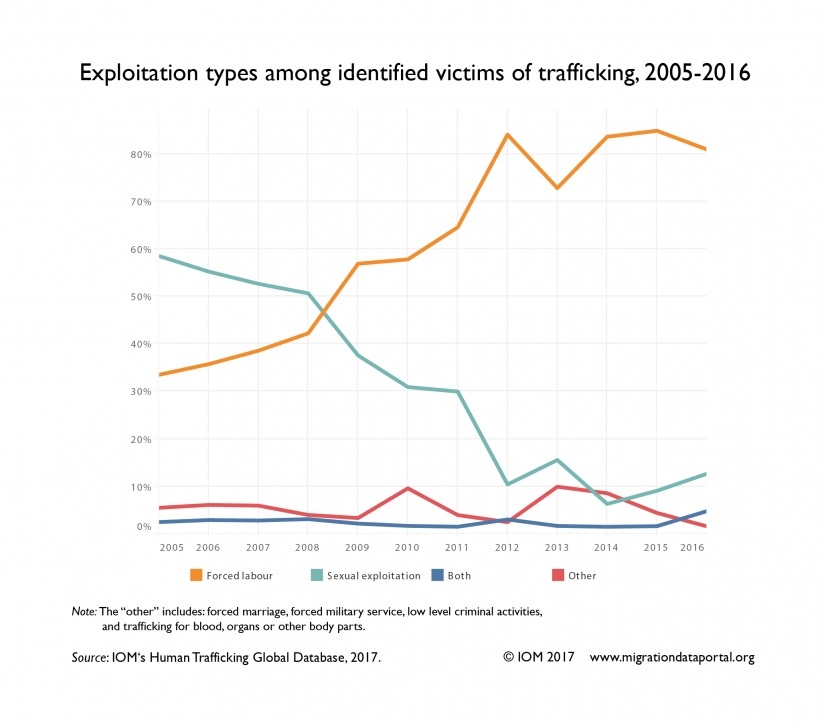Legalizing Prostitution: Does it Increase or Decrease Sex Trafficking?

This is part of a forthcoming Global Policy e-book on modern slavery. Contributions from leading experts highlighting practical and theoretical issues surrounding the persistence of slavery, human trafficking and forced labour are being serialised here over the coming months.
Ronald Weitzer examines the evidence on legalizing prostitution from two sources: large, multi-national correlational studies and in-depth case studies. He argues the latter provide a far superior evidential base on which to formulate public policies.
Some anti-trafficking activists and organizations claim that legalizing prostitution adversely affects the well-being of sex workers, including their vulnerability to trafficking. Others claim the contrary, which is consistent with the conventional understanding that bad actors and organized crime thrive under conditions where a commodity or service has been criminalized, not legalized. Are these claims evidence-based? Does legalization affect the well-being of sex workers or impact the level of human trafficking into a country and, if so, what are these effects? When elected officials debate changes to prostitution laws, what kinds of data should inform their deliberations? This essay examines the evidence from two sources: large, multi-national correlational studies and in-depth case studies. I will argue that the latter provide a far superior evidential base on which to formulate public policies.
Two studies by economists have attracted favorable attention from anti-prostitution activists and policymakers in several countries. The studies have been invoked as definitive evidence when the issue of legalization is being considered by legislatures or in the media, as recently as 2021 when Oregon, New York, Vermont, and Louisiana were considering bills to legalize prostitution. Anti-legalization forces cite the studies as definitive evidence supporting their position.
Using information on 161 countries from the United Nations Office on Drugs and Crime (UNODC) or a subset of European countries in the same source, Cho, Dreher, and Neumayer and by Jakobsson and Kotsadam published two papers in 2013. The studies rely on UNODC figures despite the fact that UNODC had cautioned against doing so because “the report does not provide information regarding actual numbers of victims” and because of unstandardized definitions, sources, and reporting across countries, with some conflating trafficking, smuggling, and irregular migration. The authors of the two studies concede that it is “difficult, perhaps impossible, to find hard evidence” of a relationship between trafficking and any other phenomenon and that “the underlying data may be of bad quality” and are “limited and unsatisfactory in many ways.” Yet they nevertheless treat the UNODC report as a serviceable data source and conclude that nations that have legalized prostitution have higher rates of human trafficking than countries where prostitution is criminalized.
The authors categorize the 161 countries according to the legal status of prostitution in each and then match them to the “amount” of human trafficking into the country. At first glance, this seems like a straightforward and worthy comparative exercise, but there are several fatal flaws in the methods and logic:
The Data
Figures on trafficking at the country level come from UNODC’s unstandardized hodgepodge of 113 sources for the rather dated 1996-2003 time period: NGOs, IOs, governments, research institutes, and the media, but not necessarily most or all of them for any given country. It is impossible to determine the quality of such diverse sources across so many countries. Although Jakobsson and Kotsadam claim that this “broad range . . . improved data quality,” a single reliable source would be far superior. There is much room for error when the sources are inconsistent across countries.
The amount of trafficking is influenced by a variety of push and pull factors—not just the legal regime at the destination. It is difficult to control for all of the potential influences on trafficking when many of them cannot be measured across all 161 countries due to lack of reliable measures.
The Analysis
The authors use aggregate human trafficking figures—combining labor, sex, and other kinds of trafficking—in their attempt to assess whether prostitution laws make a difference. The variables are clearly mismatched: In assessing whether a legal regime is related to the incidence of trafficking, it is obvious that figures on sex trafficking alone should be used, not the totals for all types if trafficking.
Cho downplays the mismatch in another paper: “prostitution is closely linked to human trafficking because sex trafficking for the purpose of prostitution is the most common form of human trafficking and constitutes the largest fraction of trafficking victims.” Even if this were true, it still introduces an unknown amount of error into the analysis. But it is not true. The U.S. State Department reports that “the majority of human trafficking in the world takes the form of forced labor” and the International Labour Organization concurs: “Forced commercial sexual exploitation represents 11% of all cases” of trafficking worldwide. The International Organization for Migration reported an identical figure for 2016 (the most recent year in the following graph) and even fewer in the two previous years.

A cross-sectional research design (at a single time point) is used to measure a relationship that should be examined longitudinally: the amount of trafficking before and after legalization in a particular country. This approach would require valid baseline figures to compare to reliable recent figures—neither of which exist for any country.
The authors use secondary sources to categorize the relevant laws, rather than carefully classifying regimes themselves. Just as seriously, the core constructs are crudely operationalized. The authors trichotomize the key variable: completely illegal, third parties illegal, legal and regulated. This scheme occludes finer variations:
- the different types of prostitution that are legally allowed and outlawed, which differs radically from one legal system to another;
- the different kinds of regulation inscribed in laws where it is legal. Legal prostitution is not monolithic in either the activities permitted or the kinds of regulations in effect;
- whether the laws are implemented and enforced. The studies are restricted to “law on the books,” not “law in action.” To hinge an analysis solely on the letter of the law, rather than whether and how it is applied, ignores potential disjunctions between theory and practice. Some countries ban all types of prostitution yet tolerate it and rarely enforce the law. The authors of the two studies would classify these nations as prohibitionist but the reality on the ground belies this categorization.
Let me expand on the first point. In most countries or states where prostitution has been legalized, it is not unusual for the law to pertain only to certain kinds of prostitution. In one Australian state, for example, all types of prostitution are legal except escorting. In another Australian state, the only type that is legal is escorting. Bar prostitution is banned throughout Australia but permitted in parts of Mexico, Germany, and Switzerland. The only type of prostitution that is legal in Britain is the sole operator working out of his or her residence (two or more at the same location is deemed an illegal “brothel” by law). Street prostitution remains either discouraged or outlawed in most countries where some other type(s) are legal. How did the authors deal with this kind of complexity? It is hardly satisfactory to simply state, as Cho and colleagues do, that “we will avoid such complications by assuming that there is one single market for prostitution.” Insofar as the legal status of diverse types of prostitution is mixed, there is no empirical justification for labeling that nation’s system as “legal” or “illegal.” As it is criminalized in half of Australia’s states but legal in the other half, how did the researchers categorize Australia? And we can ask the same question regarding the varying state systems across Germany, Mexico, and elsewhere.
Finally, nations where some or all types of prostitution are legal may have superior mechanisms for detecting sex trafficking, a variable missing in both studies. A significant number of confirmed victims in a state with legal prostitution may be an artifact of superior oversight, investigation, or reporting by the authorities, as the Dutch Ministry of Justice argues. Such cases would then produce a significant amount of error in a study, since the relative success of the authorities in combating trafficking would produce higher official numbers than a country with little capacity or will to enforce its trafficking laws.
But there is more to the story, as the very logic of the two studies’ central argument is the inverse of what should be expected. Organized crime is attracted to places where a good or service has been criminalized. The demand is satisfied by the black market. Organized crime, in the form of group-level provision of illicit drugs, weapons, or human trafficking victims thrives where the goods and services cannot be obtained legally. The history of prohibition of alcohol, gambling, and drugs testifies to this fundamental principle. We should therefore expect illegal operators and bad actors to fill the vacuum created by criminalization. Legalization is based on the obverse principle: over time, state regulation and oversight will squeeze bad actors out and help normalize transactions. Having said that, much depends on the kinds of state regulation in place and the degree to which the formal protections and oversight mechanisms are implemented and enforced, as illustrated below.
Case Studies
Case studies—the inverse of the multi-national approach—are a superior method for discerning the impact of the law on the operation of businesses that were previously criminalized. The cases presented here suggest not only that legalization can be superior to criminalization but also that it can be considered preferable to laissez-faire decriminalization, as in the following example. To generate revenue for the state, Nevada decriminalized casino gambling in 1931 (prior to that, gambling was widespread and a felony). Organized crime became involved immediately. Mobsters funded and ran some of the casinos and operated behind the scenes in other casinos, skimming millions of dollars each year and occasionally using violence to intimidate owners. This state of affairs continued for three decades, until the state began to intervene. In 1959 the Nevada Gaming Commission was created in an effort to clean up the industry by licensing operators, conducting inspections of casinos, monitoring security measures, collecting taxes, and investigating consumer complaints. The commission had the authority to deny or revoke licenses, and it immediately began to revoke some. However, it took many years to fully reform the industry, and it wasn’t until the mid-1970s that the involvement of organized crime became negligible. When New Jersey legalized casinos in Atlantic City in 1978, it learned from Nevada’s experience and imposed many of the same regulations, as have all subsequent states in the U.S. and the eight European nations that permit casino gambling.
Nevada’s casino history shows that sensible state regulations can greatly reduce if not eliminate bad actors after a vice has been decriminalized. This applies to human trafficking as well. Criminalization, not legalization, increases risks. A survey administered to 4,559 sex trafficking victims who had sought services at European field offices staffed by the International Office for Migration, concluded:
These results confirm results of many other studies that have looked at the consequences of criminalization policies. Whenever sex work has been criminalized, sex workers have been moved to more secluded places with the consequences of being more exposed to different kinds of risks: assault, fraud, control, and lack of freedom.
The Netherlands legalized prostitution in 2000. Since then, government officials have conducted periodic site visits to erotic businesses to ensure compliance with the law. Annually, more than 1,000 checks of window-prostitution units are conducted by police, health officials, and other government agencies. Outside of these red-light districts, officials also visit escort agencies, brothels, and massage parlors. According to the Ministry of Justice, “Few instances of abuse are found during these inspections. The high frequency of the inspections and the consequences of the sanctions for operational management are major contributing factors in compliance by operators, as well as the operators’ own sector-wide standards.” Regarding trafficking, an earlier Ministry of Justice report concluded that, since legalization in 2000, “it is likely trafficking in human beings has become more difficult, because the enforcement of the regulations has increased.”
Prostitution has been allowed in Germany since 1927, but prior to 2002, owners of erotic businesses were unregulated, pimping was illegal, and the criminal law defined prostitution as “contrary to public decency and morality.” In 2002, parliament changed the law by defining prostitution as an occupation; giving sex workers the right to health care, social security, and unemployment benefits; and revising two offenses.
What followed was a drastic reduction in the number of intermediaries arrested. Whereas in 2000 there were 1,365 cases involving third-party “exploitation of prostitutes” (§180a), the number steadily declined after the 2002 law was implemented, to 45 in 2014; for the same time span, the figures for pimping/procuring/promotion (§181a) fell from 1,104 to 256 and for sex trafficking (§232) from 1,016 to 482. The fact that some individuals are still arrested under these three statutes suggests a more sophisticated assessment of the ways in which third parties and employers interact with sex workers, compared to the past. Instead of being liable for pimping/promoting prostitution, the law now prohibits specific acts that curtail a worker’s autonomy by, for instance, dictating the type of services that must be provided, forcing a worker to engage with a particular client, preventing someone from exiting prostitution, or restricting freedom in other ways. Similarly for employers: “exploitation” is now restricted to keeping someone “personally or financially dependent” on their business operation (e.g., permanent debt bondage); this is where we see the greatest decline in arrests since the law was passed. The law governing sex trafficking was not modified, yet there were less than half as many trafficking cases in 2014 than in 2000. Arrests and prosecutions do not necessarily track incidence, but if legalization increases trafficking, we should expect arrests to have increased significantly after 2002. The decline may mean that legalization reduced the involvement of bad actors.
The Australian state of Queensland legalized brothels and independent escorts in the 1990s. A government agency reports that legal prostitution offers a range of advantages: “There is no doubt that licensed brothels provide the safest working environment for sex workers in Queensland. Legal brothels now operating in Queensland provide a sustainable model for a healthy, crime-free, and safe legal licensed brothel industry” and are a “state of the art model for the sex industry in Australia.” Official corruption and organized crime “are not of significant concern for the legal prostitution industry in Queensland.” Research on the sex workers themselves found that many of them are satisfied with their work. Of the 205 independent escorts and licensed brothel workers interviewed in one study, 70% said they would “definitely choose” this kind of work if they had to do over again, and half felt that their work was a “major source of satisfaction” in their lives. Almost all (97%) of the brothel workers said that an advantage of working in a legal brothel was the safety it provided.
Tijuana, Mexico allows us to compare outcomes for sex workers who work legally and illegally in the same city. Certain areas are designated for prostitution; sex businesses are licensed; the authorities conduct site visits; and legal sex workers are required to register and carry health cards indicating that they have been tested for STIs. Research comparing legal workers with those who work illegally found that the legal sector has several advantages. First, the legal workers had superior health profiles. Second, those working illegally were twice as likely as the legal workers to have been assaulted, robbed, or kidnapped and three times more likely to experience extortion or violence by police officers. Third, there were several intangible advantages:
Legal status allows them access to the safest and most profitable venues, affords protection from the police, and facilitates the professionalization process. . . . [They enjoy] better working conditions and job satisfaction, less fear about the nature of their work, a higher degree of sophistication and confidence with regard to their speaking skills, appearance, and demeanor. Registration and monthly checkups appear to encourage behaviors that are protective of health as well as provide a barrier against police harassment. Registration increases the sense of legitimacy and community and is correlated with much lower levels of depression and mental stress.
Another major study compared different regimes in three Australian cities: criminalization in Perth (Western Australia), decriminalization in Sydney (New South Wales), and legalization in Melbourne (Victoria). On all of the health and safety measures, legalization ranked superior to criminalization. It also performed better than decriminalization, because legalization implies some kind of state regulation whereas decriminalization is a non-interventionist, laissez-faire approach. Melbourne’s legalized brothels were associated with more security measures and health protections than in the other two cities, and a greater proportion of its brothels were awarded a 5-star rating by data collectors who visited each site.
In contrast to the macro-level studies critiqued earlier, the case studies briefly discussed here highlight the importance of examining micro-level policy implementation and the best available data on how sex workers actually fare under different regimes, rather than assuming that they are monolithically affected by the letter of the law. Traffickers, like other organized criminals, gravitate to places where opportunities are greatest, which means that a prohibition on a desired commodity or service is a magnet for them. This principle is fully understood by those who have sought, historically and today, to end prohibitions on alcohol, gambling, drugs, and other vices.
Legalization vs. Decriminalization
Research documents substantial variation among legal prostitution systems. Some rely on regulations that are sound and can be considered best practices, while others impose rules that are overly burdensome for sex workers or the owners of the businesses they work for or have the effect of marginalizing certain types of workers. Requiring sex workers to register with the authorities and mandatory counseling and condom use (Austria, Germany) are almost universally disliked by sex workers, and excessive restrictions on businesses (the Netherlands) have been counterproductive as well. Nevada’s legal brothels are subject to strict rules and extremely tight control, diluting the rights of workers and brothel owners alike. By contrast, New Zealand and New South Wales, Australia, operate fairly minimalist regulatory systems.
Sex worker rights’ groups universally favor decriminalization over legalization. Decriminalization means that criminal penalties are removed, leaving participants free to operate as they choose, subject to the rules pertaining to any other business. Unlike legalization, there are no regulations specific to the sex industry. Many sex workers are averse to any regulation whatsoever. In a survey of 247 sex workers in San Francisco, two-thirds of whom worked on the streets, 8 out of 10 agreed that “sex workers should determine their own working conditions without being taxed or regulated by government,” and only 2% agreed that sex workers should pay taxes on their earnings. Three-quarters felt that street sellers should be allowed to operate anywhere they choose, and a mere 13% felt it should be banned near churches, hospitals, and schools.
This laissez-faire approach is anathema to politicians and the wider public. For those who are open to removing criminal penalties, some kind of regulation is preferred. More importantly, unfettered decriminalization perpetuates risks to sex workers themselves as it does nothing to sideline bad actors. Without some kind of state oversight, exploitation is likely to continue in brothels, massage parlors, bars, and other erotic businesses.
The three-city Australian study mentioned above provides some evidence that legalization can be superior to decriminalization, and research in Belgium confirms this point. In Brussels, those who run sex businesses operate virtually free of any government control. Like Antwerp and Ghent, Brussels’ red-light district contains window-prostitution rooms where women are visible from outside and sell sex inside. But unlike Antwerp and Ghent, city authorities take a radically lax approach to the area. Police rarely enter the district; buildings are in disrepair; security cameras are absent; officials conduct no background checks on third parties or site visits to monitor working conditions; police tend to ignore crimes against the window workers; and madams exercise total control over them. Many of the madams are connected to organized crime networks based outside of Belgium, and they exercise tight control over the African or Eastern European women working for them. By contrast, the authorities in Antwerp and Ghent impose strict rules on the owners of window units and the workers are periodically interviewed by social workers and health providers to ensure that their health and safety are being protected and that they are working voluntarily. Security cameras are visible and each district has its own designated health center, offering free services. Uniformed and undercover police officers patrol each district. The authorities in Brussels, by contrast, do almost nothing to control business operators, combat bad actors, or support the sex workers.
The comparison suggests that there can be serious problems with unfettered decriminalization. But the latter is, in fact, quite rare worldwide. When a system based on criminalization is dismantled, a two-step process usually follows: decriminalization followed by legalization. Criminal penalties are removed and regulations are imposed and, again, what matters is the nature of those rules. Do they unreasonably encumber sex workers and erotic business owners, or do they enhance their rights, health, and safety? These are the questions policy makers grapple with when legalizing gambling and drugs as well.
Ronald Weitzer is professor emeritus of sociology at George Washington University in Washington, DC. He has conducted extensive research on various aspects of sex work in several countries, including legal prostitution systems in Europe. Among his contributions on human trafficking are a co-edited issue of the prestigious Annals of the American Academy of Political and Social Science (May 2014).


